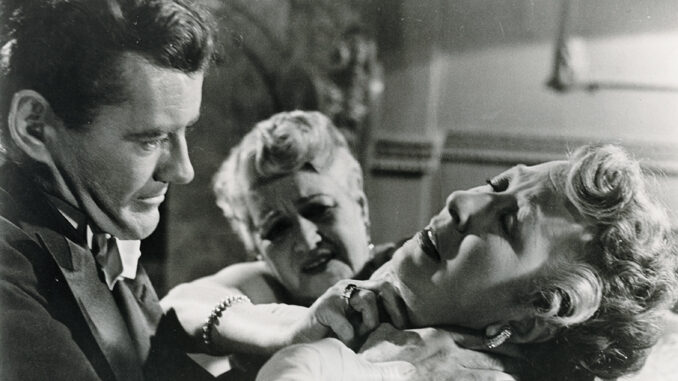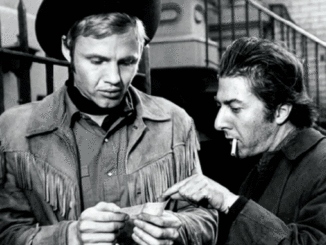
by Kevin Lewis
The signature Alfred Hitchcock thriller frequently involves an innocent person accused of a politically motivated murder committed by twisted villains who are terrorists, Nazis, fascists or Communists. This is true from The 39 Steps (1935) to North by Northwest (1959). But it is his psychosexual shockers which are most cherished, such as Rear Window (1954), Vertigo (1958) and Psycho (1960).
Strangers on a Train (1951), which celebrates its 60th anniversary in July, began this transition from political thriller to true perversion. It has no political overtones despite its obvious political setting of Washington, DC. Hitchcock meticulously creates a plush drawing room-style murder scandal to subtly camouflage the perversity of the urbane ruling class, a kinkiness associated with the aforementioned later masterworks. The plot involves Senator Morton’s (Leo G. Carroll) daughter Anne (Ruth Roman); her boyfriend Guy Haines (Farley Granger), a married tennis star accused of murdering his wife; and psychotic serial killer Bruno Antony (Robert Walker).
The film has many of the standard Hitchcock touches (the wrong person framed for murder, a suave but dandified villain and eccentric subsidiary characters), but Strangers is different from his earlier work––not only because of its graphic violence but because the psychopath, rather than the romantic leads, is the main character. The killer who is rich and devoid of empathy is used as a symbol of a new post-war class based on money and celebrity worship.

Hitchcock based his film on the novel by Patricia Highsmith, who later wrote The Talented Mr. Ripley. The polished serial killer Ripley could be an evil twin to Strangers’ Antony. Highsmith explored the theme of the killer who passes for normal in her novels and gets away with murder. Hitchcock was fascinated with this theme and character, but was con- strained by the then-in-effect Production
Code from depicting unpunished crime. However, with Antony in Strangers, as well as Norman Bates in Psycho and Bob Rusk in Frenzy (1972), the director created unforgettable psychopaths who kill women while idolizing their dotty mothers, and deliberately implicate another in their crimes.
The film also shares thematic similarities with A Place in the Sun (1951), the Oscar-laden film of that same year, which was also based on a novel, An American Tragedy by Theodore Dreiser. The lower- class heroes of both films have the opportunity to marry heiresses. However, both are involved with pregnant women whom they need to vanish from their lives.
In Strangers on a Train’s case, it is Haines’ unfaithful wife, pregnant by her lover, who refuses to divorce the tennis star, whose fame is his ticket into social status with a senator’s daughter. A chance meeting of two strangers––a tennis fan (Antony) and the tennis champion––is the premise for an alibi-proof murder; Antony will murder Miriam, Haines’ wife, while Haines will kill Antony’s father, who plans to commit his son to a mental hospital. When Haines humors Antony with a laugh and a toast over lunch, the latter accepts this as an agreement and murders Miriam. A shocked Haines avoids him, so Antony stalks him at his matches and cocktail parties, believing that the tennis star has double-crossed him. Haines left his monogrammed cigarette lighter behind on the train, and Antony intends to plant it at the murder scene to frame him.
Hitchcock created his own version of Jean Renoir’s The Rules of the Game (1939) with this examination of a heart- less ruling class. Compare the party scene in Rules, in which the gamekeeper stalks the poacher with his gun among the high society guests in the ballroom, with the scene in Strangers where Antony re-enacts the tabloid report on the strangulation (that he himself committed) on a thrill-seeking elderly grande dame (Norma Varden) at Senator Morton’s cocktail party.

A legend persists that there are both an American version and a British version of Strangers on a Train. The so-called British version is really a sneak preview print, which was never returned to Warner Bros. after it was shown in the United Kingdom in 1951. It was re-dis- covered in 1991. There were two endings shot for the film, one of which appears in the preview print and the other in the final release print that is well known.
Hitchcock wanted the film to end with an unrepentant Antony being fatally crushed under the crashed carousel, and Haines’ cigarette lighter dropping from his dead hand. The vindicated Haines comments that Antony “was a very clever fellow.” But Warner Bros. studio head Jack Warner preferred a more romantic ending after that scene, so two coda scenes were shot by Hitchcock. In the first, Anne receives a phone call from Haines while she is with her family. She relays his message to bring him clothes because he “looks silly in tennis clothes.” That is the end of the movie in the pre- view/British version.
But Warner was still not satisfied, so the second coda ending was selected, which is in the final release version. After Anne answers the phone call from Haines, the line about the tennis clothes is cut out and the scene dissolves into a train compartment. There, we see the honeymooning Haines and Anne approached by a clergyman, who asks if he is Guy Haines. The once-burned couple knows better than to talk to strangers––even a clergyman––so they run away from him in the final scene.
On the Strangers on a Train “Special Edition 2-Disc” DVD from Warner Home Video, which includes both versions of the film, historian Bill Krohn states that Hitchcock preferred the tennis clothes ending but Warner prevailed on the clergyman ending; the film thus begins and ends on the train.
Walker’s masterful performance as Antony continues to fascinate after repeated viewings because his evil is hid- den under boyish, spoiled charm (many film critics regard Antony’s flirtatious seduction of Haines as homosexual). At the time, Walker was a fading MGM heartthrob star whose vogue peaked during World War II portraying naïve GIs. He became an alcoholic over the theft of his wife, Jennifer Jones, by her producer and Svengali David O. Selznick. Strangers on a Train turned his career around, but he was dead from alcoholism within a year.

Granger was another teenage idol from the 1940s, who changed his image playing one-half of the fictionalized gay Loeb and Leopold characters in Hitchcock’s Rope (1948). Roman was groomed by Warners as a replacement for its older dramatic stars Joan Crawford and Barbara Stanwyck. Patricia Hitchcock, the director’s daughter, steals the film as Anne’s kid sister Barbara, an amateur criminologist who could be Antony’s next victim. But the lack of A-list movie stars in Strangers makes the film stand on its own merits, as opposed to Hitchcock’s films with screen legends like Cary Grant, James Stewart and Ingrid Bergman.
The only Oscar nomination the film received was for the black-and-white cinematography of Robert Burks, who became the director’s favorite DP over the next decade. Several scenes in Strangers are among the most indelible in film history, such as the scene where Antony strangles Miriam, which was shot from the ground up through Miriam’s dropped eyeglasses; the scene where Antony ’s fingers desperately try to retrieve Haines’ monogrammed cigarette lighter from the sewer; the tennis match intercut with Antony planting the lighter at the fairgrounds; and the out-of-control carousel.
William Ziegler was not nominated for his seamless cutting, also one of the most accomplished editing feats––per- haps because it was well known that Hitchcock storyboarded every shot. In his book Hitchcock at Work (Phaidon Press, 2000), Krohn points out that the director created this storyboard myth and shot alternate versions, but it may have cost Ziegler his recognition as a creative collaborator.
The success of Strangers on a Train revived Hitchcock’s fading career after four poorly received movies in five years. He realized that an Atomic-Age audience relished edgy, audacious subject matter because post-war life became less certain, less defined and more cynical. He became a household name with his macabre television series, Alfred Hitchcock Presents (1955-60), a mystery magazine and some of the greatest warped films in world cinema.





